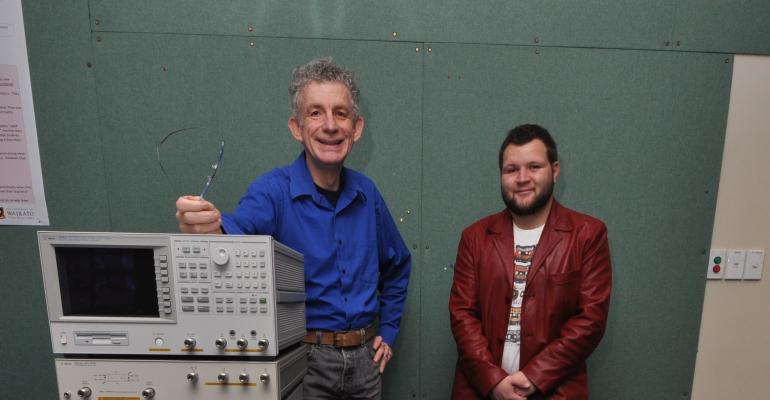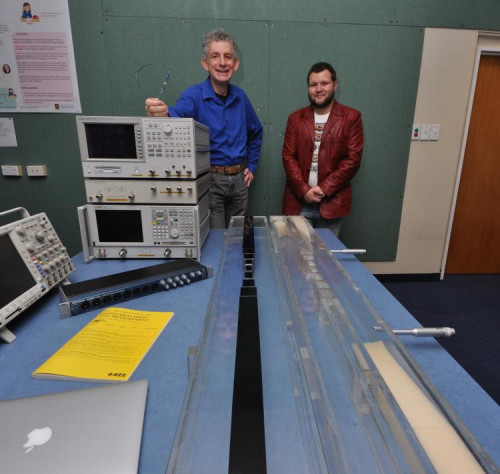
Professor Jonathan Scott
Sounds precise
What if a piece of technological equipment, vital for the manufacture of radio, radar, blue tooth and wireless could be converted from measuring radio waves to measuring sound?
Vector Network Analysers (VNAs) are vital in the manufacture of anything that uses radio waves. They are expensive, specialised pieces of equipment costing anything from $10,000 to $250,000 and are made by just a few companies around the world.
SfTI Seed researcher Professor Jonathan Scott of the University of Waikato, who likes his music, says it occurred to him many years ago when he was in the market for Hi-Fi speakers that the wave length of sound in the air is similar to the wave length of radio waves in space.
“I thought that if you could apply the decades of VNA technology to sound, you’d be able to drastically improve the measurement of it. You could make acoustic absorption and transmission measurements traceable and precise. That could tell you how to improve the performance of a lot of things.”
Possible applications for significantly improved measurement of acoustic properties could include rating the absorption properties of furnishings and architectural materials, estimating the dry-yield of pasture, refining musical instruments, improving and certifying ear plugs, precisely measuring the ultrasound properties of tumours, and even creating acoustically stealthy weaponry.
Jonathan’s SfTI project is tackling this idea with the development of an Acoustic Vector Network Analyser, which applies the existing VNA tech.
“We can measure sound frequency and loudness already, but the Acoustic VNA measures the extent to which sound waves bounce off something, and the extent to which they are absorbed. If you’re looking at building materials, you could use this to rate the ones that will absorb more of the unwanted sounds and make it easier to hold a conversation. If you’re designing a stealth torpedo, it could help you design a weapon that’s not visible on sonar. If you’re seeking a way to identify tumours with ultrasound, you could find out what separates the tumour from the normal tissues surrounding it. You could analyse the efficiency with which a flute or trumpet translates the musician’s efforts into sound.”
“...it could help you design a weapon that’s not visible on sonar.”
Jonathan says the project is progressing well and is providing preliminary results that show the theory is right.
“But it’s extremely difficult to prove the software has got no bugs in it.”
Once the software’s proved, there will be other challenges to commercialisation.
“It’s the common story that the leap from a working prototype to a manufacturable product involves crossing a chasm. I’m sure farmers would be very pleased to be able to easily measure the dry feed yield of a paddock, but right now we’ve got a delicate, suitcase-sized, mains-powered thing that you’re not really going to be able to sling onto the back of your quad bike.”
“However, we’re pretty convinced that for the first time ever, it’s possible to build a VNA that works in sound, and that in itself may be just the exact thing another researcher needs to know some day.”
Jonathan says the Acoustic VNA stands on the shoulders of previous research.
“When we first started thinking about this, we just couldn’t do it. But then we stumbled across an obscure publication by a guy who had managed to invent a directional coupler in sound, published a paper, and done nothing else with it. That was in 1971, and that coupler, invented by Lagasse, has become the heart of our machine. We wanted to tell Lagasse ‘thank you so much for that little piece of work’ because it saved us, but it was work done so long ago we couldn't find out what happened to him. Perhaps our work will be just what future researchers need, even if it doesn't become a successful product this time around.”
Jonathan and team members Marcus MacDonnell from the University of Waikato, and Dr John Cater from the University of Auckland have made significant advancements so far and are working hard on the software challenges.
“We’re converging on a solution,” Jonathan says. “But let’s just say a professional mathematician might be handy about now.”
